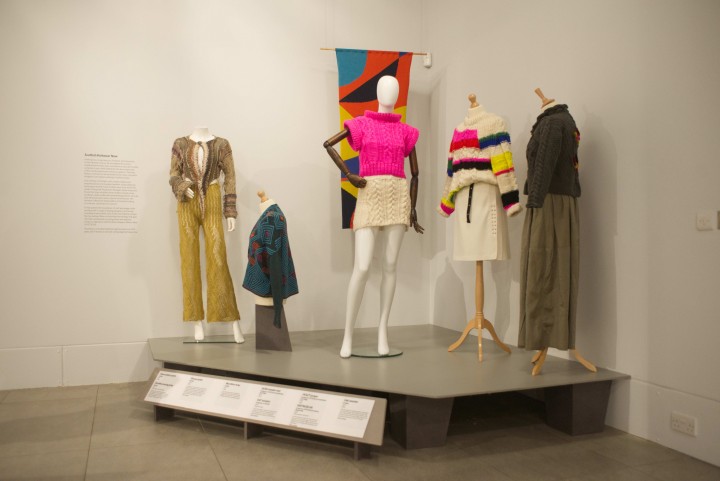Scottish Art News
Latest news
Magazine
News & Press
Publications
The Fashion Capital
By Susan Mansfield, 08.12.2022

In the mid 1960s, models on catwalks for Chanel, Dior and Yves Saint Laurent were all wearing fabrics designed in the Scottish Borders by one Bernat Klein. The colour-flecked mohair tweeds he created by combining traditional weaving techniques with modern colour mixing were just right for the structured suits and coats so beloved of the time.
Unlike most textile designers, who tended to sell their work through global agents and remain invisible to the public, Klein grew his own brand, had shops in Paris, London and Edinburgh and worked successfully across couture and ready-to-wear fashion and interiors.
Serbian and Jewish, he studied Fine Art at the Bezalel School of Arts and Crafts in Jerusalem under Bauhaus alumnus Mordecai Ardon. Post-war, he came to the UK, settling in the Borders where he launched his own company Colourcraft Ltd in 1952. He died in 2014 and this is the first exhibition based on his archive, which entered the National Museum of Scotland (NMS) collection in 2010.
 Sample of fashion fabric entitled Maple, Bernat Klein, 1961. Image © National Museums Scotland.
Sample of fashion fabric entitled Maple, Bernat Klein, 1961. Image © National Museums Scotland.
It’s an overview, a show to whet the appetite for more in-depth explorations of his work and his legacy. It includes paintings (he continued to paint all his life), parts of his 5000-piece “colour dictionary” of samples, and some beautiful clothes, from a coat and dress in mohair tweed which belonged to Klein’s wife Margaret, to a glorious 1970s kaftan in seawater shades.
Versatile and inventive, Klein took his Galashiels mill from making scarves for Marks & Spencer into couture fabrics, and later into a mail order business, fabrics for home dressmakers and even a range of yarns and knitting patterns. As a colour consultant, he designed homes for MoD service personnel and interiors for the QE2.
And, like an Instagram influencer, he did not balk at using his striking modernist home, High Sunderland near Selkirk, designed by Peter Womersley, to help build his brand identity. The collection in NMS numbers some 4000 objects, so one must hope there are more shows - more clothes and more stories - to come.
 Gabrielle Chanel on the beach in Etretat. © CHANEL Private Archives. All Rights Reserved.
Gabrielle Chanel on the beach in Etretat. © CHANEL Private Archives. All Rights Reserved.
Meanwhile, as the woollies come out of the closet for another winter, Dovecot Studios is hosting a show exploring 100 years of knitwear in fashion, created in collaboration with leading vintage collectors Mark and Cleo Butterfield for the Fashion and Textile Museum in London. While the subject has the potential to be dry and academic, this show has been put together with flair and humour, mixing couture pieces with home-knitting, the glamorous with the experimental and the downright odd.
For the Victorians, knit was all about warm, practical undergarments, so eyebrows were raised when designers between the wars, led by Coco Chanel, started using them for outer clothing: belted cardigans, elegant dresses and shapely twinsets. Meanwhile Edward, Prince of Wales, started a rage in Fair Isle pullovers when he was photographed golfing in one at St Andrews in the 1920s. And there is a surprising section on swimwear, for which the form and flexibility of knit was the most practical solution before the development of elasticated fabrics. During the war, recycling and mending became de rigueur, and home-knitting came in with a vengeance, followed, in the 1960s, by the era of the home-crocheted mini dress.

Labelling is somewhat confusing in the post-war displays, but many of the key knit staples are well represented: the 1950s cocktail sweater, the 1960s skinny rib turtleneck, Rudi Gernreich’s zip-front cardigan, Biba’s sailor-style sweater. And there are occasional pieces of stand-out glamour: the tunic, pantaloons and scarf outfit by Bill Gibb and Kaffe Fassett; the hooded cloak with feathers by Diana Leslie for Animal Rainbow.
There is punk knitting, pop-art knitting, lace-knit evening dresses by Julien Macdonald, and, at the practical end, a 1980s revival in home-knitting with patterns by designers such as Katharine Hamnett.
The final section celebrates Scottish contemporary knitwear studio, Di Gilpin, fusing Shoowa (central African) influences with traditional Fair Isle and collaborating with designers such as Graeme Black and Paul Smith. Never claiming to the comprehensive, this is a fascinating show which welcomes the enthusiast and the amateur.
Bernat Klein: Design in Colour, National Museum of Scotland, until 23rd April 2023 & Knitwear: Chanel to Westwood, Dovecot Studios, until 11th March, Admission £10.50/£9.50 concession.




